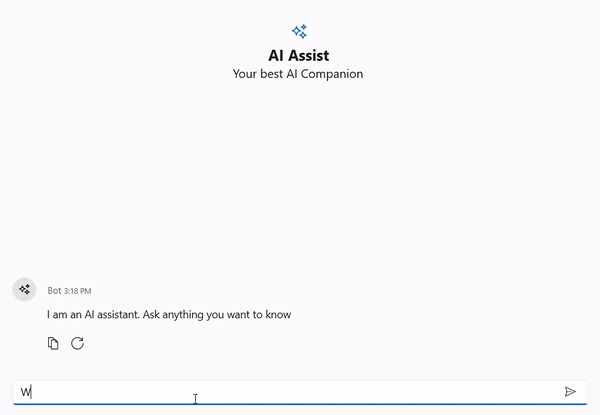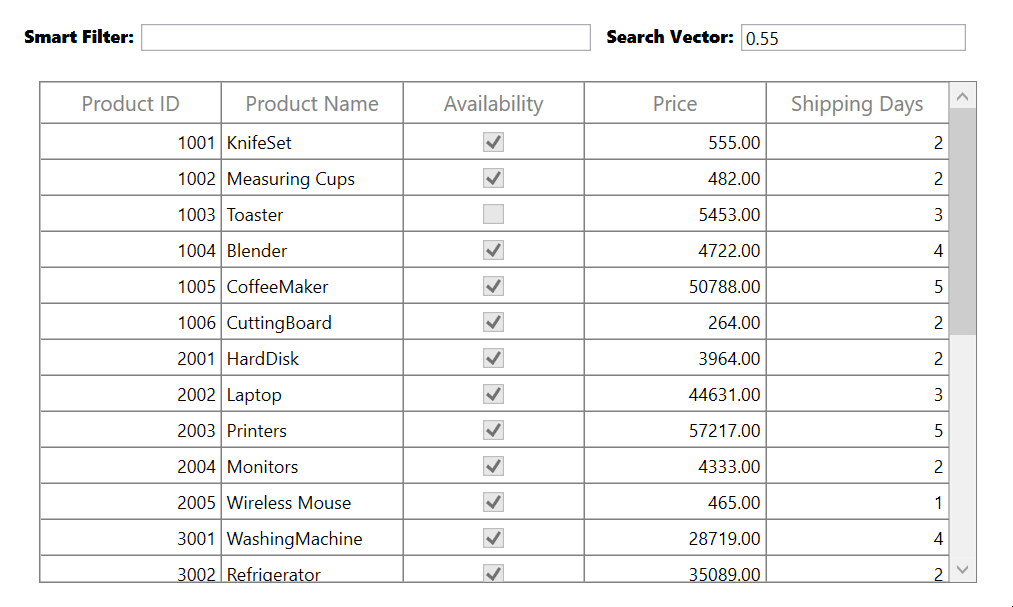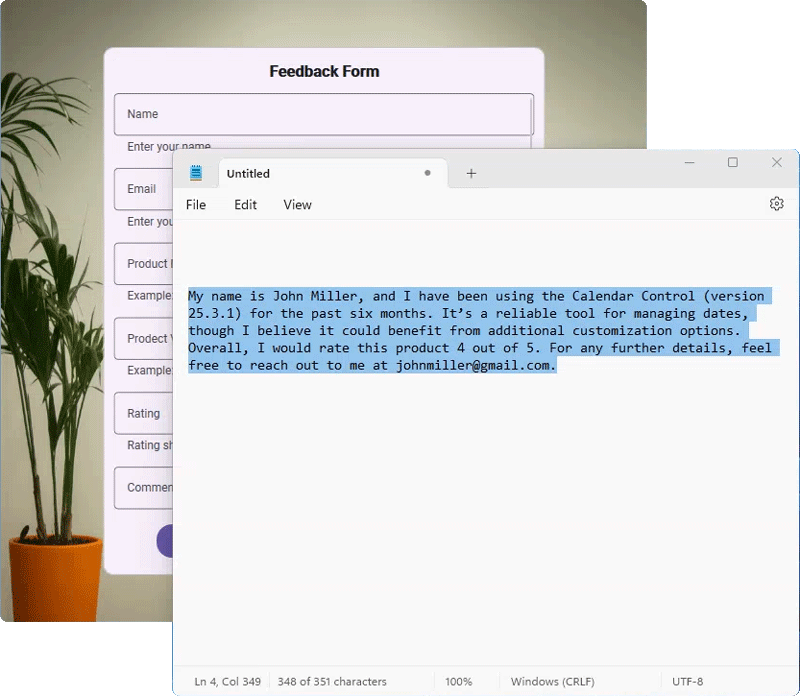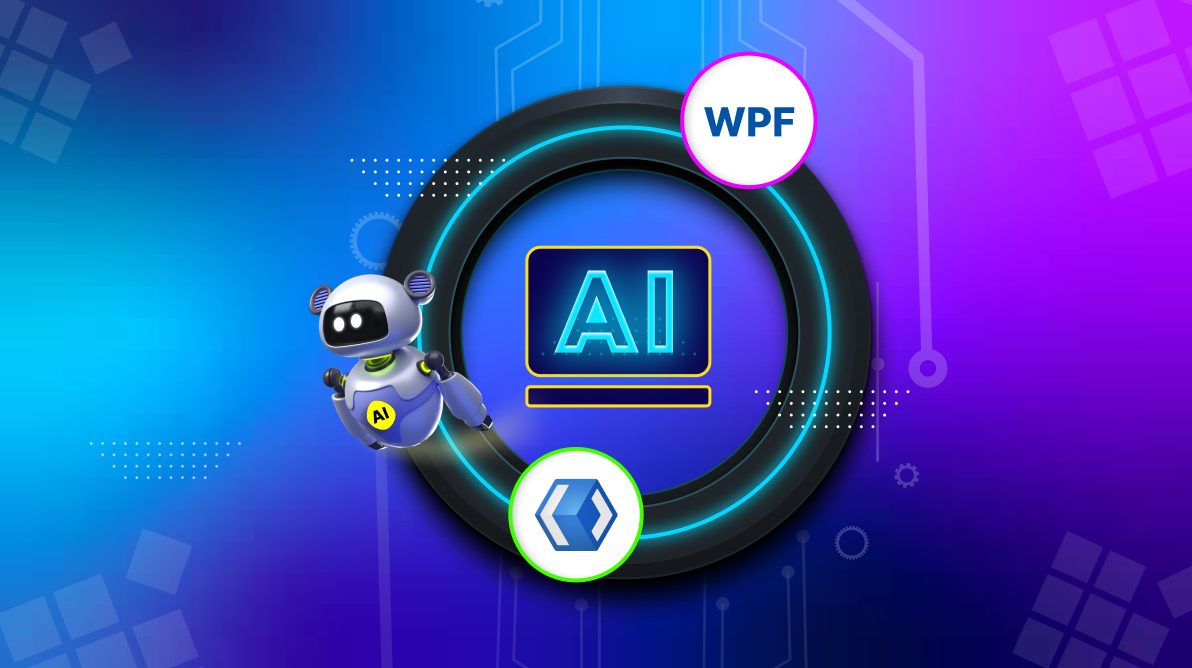TL;DR: Streamlining your desktop app development with AI-powered components in the Syncfusion WPF and WinUI suites for the 2024 Volume 3 release. Key innovations include the AI AssistView in WinUI and AI-driven data preprocessing in WPF Charts, among others.
We at Syncfusion are excited to introduce AI-powered smart capabilities to our desktop platforms, revolutionizing how users interact with applications on WPF and WinUI platforms. The 2024 Volume 3 release brings new AI-based features, including the AI AssistView in WinUI and enhancements across existing components.
Note: These features are currently in the experimental phase and are available in demo form.
Let’s explore the AI-powered smart components and features that Syncfusion brings to its desktop platforms.
WinUI AI AssistView
We’re thrilled to introduce the new WinUI AI AssistView, a significant advancement in integrating artificial intelligence with UI components. This control facilitates seamless communication between users and AI services, making it easier to build AI-powered apps. Whether you’re developing a chatbot or virtual assistant, this control provides essential features for natural, intuitive user interactions.
Key features
- Suggestions: Displays selectable response options to streamline conversations.
- Typing indicator: Shows a loading animation during asynchronous AI communication.
- Header template: Customize the header using personalized views.
- Custom views: Modify both request and response elements to fit your design.
- Appearance customization: Easily tailor the default appearance to match your app’s theme.
With features like selectable suggestions, users can interact more efficiently by choosing predefined responses, speeding up conversation flow. The typing indicator reassures users that the AI processes their input, maintaining a smooth, intuitive experience. The customizable header and response elements empower developers to create a cohesive, user-friendly interface that aligns with their app’s design.
This control is perfect for developers building intelligent, interactive, customizable apps that seamlessly incorporate AI services.

Note: For more details, refer to the WinUI AI AssistView documentation.
Smart predicate filtering in WinUI DataGrid
Smart Predicate Filtering in the WinUI DataGrid takes traditional filtering to the next level by allowing users to input natural language queries. This is particularly useful for business applications where users need to filter large datasets quickly without knowing the exact filter criteria or manually setting complex filters.
Instead of complex filter syntax, users can simply type queries like:
- Show orders above $500 in the last 30 days.
- Find products with a rating greater than 4 stars.
The AI interprets these natural language commands and automatically translates them into the appropriate filtering criteria. This feature is not only intuitive for end users but also significantly reduces the time required to sift through data, making apps more user-friendly and powerful for data analysis.
Note: For more details, refer to the Syncfusion WinUI DataGrid GitHub demo.
AI-powered data preprocessing in WPF Charts
The new AI-powered data preprocessing in the WPF Charts is a game-changer for developers dealing with large datasets and complex data-cleaning tasks. Traditionally, preprocessing involves addressing missing values, detecting outliers, normalizing data, and other time-consuming data manipulation steps.
With this AI-driven feature, the chart component automatically handles these tasks, ensuring that only clean, accurate data is presented for analysis. The AI detects and resolves anomalies, allowing for better insights without requiring manual intervention. This streamlines the entire process, ensuring your data is ready for accurate and actionable analysis.
This capability is precious in sectors like finance, healthcare, and any domain where clean data is essential for informed decision-making.
Note: Explore this feature more in Clean and Preprocess E-Commerce Website Traffic Data Using an AI-Powered Smart WPF Chart blog.
AI-powered smart features in WPF DataGrid
Smart predicate filtering
The smart predicate filtering feature in the WPF DataGrid transforms the way users filter data by allowing them to input natural language queries. This eliminates the need to manually set complex filter criteria, streamlining the process.
For example, users can simply type:
- Show employees earning more than $2,500.
- Find female employees above the age of 45.
The AI instantly interprets these queries and applies the appropriate filters, automating the entire process. This dynamic filtering is particularly useful in data-heavy apps, where users need to quickly sift through large datasets to make fast, accurate decisions.
This feature significantly enhances productivity, offering a powerful and intuitive way to manage and analyze large volumes of data with ease.
AI-powered view filtering
This feature simplifies filtering by dynamically applying filter conditions based on user-provided natural language queries. Instead of manually selecting columns and filter conditions, users can provide input like:
- Find design engineers whose names start with ‘K’
- Show male employees with a rating greater than 5
The AI processes these requests and applies the appropriate filters, making it easy to search and filter complex datasets quickly and efficiently.
Note: For more details, explore the AI-powered view filtering in the WPF DataGrid GitHub demo.
Semantic searching and embedding
Traditional keyword-based searching relies on exact matches between the input and the data, which can sometimes yield incomplete results. Semantic searching goes beyond keywords; understanding the context of the input to provide more relevant search results.
For instance, a search for “employees with high performance” could return results that include synonyms like “top performers” or “high achievers.” This search method improves the accuracy and relevance of results, making it easier for users to find the details they need.
This feature is powered by Embedding, which converts words and phrases into numerical vectors that the AI model interprets. This process allows the AI to understand the deeper meaning behind user queries and perform similarity searches. Using local embeddings, developers can perform these searches without relying on external AI services, improving performance and security.

Note: For more details, refer to the Semantic searching using Embedding in the WPF DataGrid GitHub demo.
Smart location finder in WPF Map
The Smart location finder in WPF Map uses AI to allow users to search for and find specific locations more effectively. Unlike traditional map searches, which rely purely on keyword inputs, this AI-enhanced feature provides more accurate and context-aware results.
For example, users can input queries like “restaurants near the river” or “schools within a 5-mile radius of downtown,” the AI processes these queries to find the best matching results.
This functionality is handy for navigation apps, real estate platforms, or any app requiring geographic information systems (GIS).

Note: For more details, refer to the AI-powered location search in the WPF Map GitHub demo.
Smart paste in WPF Text Input Layout
The smart paste feature in WPF Text Input Layout streamlines data entry by intelligently mapping clipboard content to the appropriate fields in a form. This AI-powered capability is beneficial when transferring data between sources.
For example, suppose a user copies a block of text from a document. In that case, smart paste automatically splits the data into relevant form fields such as name, address, or phone number, saving users time and effort.
This feature is ideal for apps involving forms, data entry, and content management, as it enhances productivity and reduces the risk of input errors.

Note: For more details, refer to the smart paste in the WPF Text Input Layout GitHub demo.
Smart fill in WPF PDF Viewer
The smart fill feature in WPF PDF Viewer automates the process of filling out PDF forms using AI. When users copy information to their clipboard, the AI analyzes the data and automatically fills in the corresponding fields.
For example, if a user copies their contact information, the smart fill places the name, email, phone number, and address in the appropriate fields in the PDF.
This feature is a major time-saver, especially in industries like legal, finance, and healthcare.
Note: For more details, refer to the smart fill in the WPF PDF Viewer GitHub demo.
Conclusion
Thank you for reading! We’re excited about the potential these AI-powered components and features bring to your development journey. These features are also listed on our Release Notes and the What’s New pages. Try out them and share your feedback as comments on this blog.
Existing Syncfusion users can download the latest version of Essential Studio®® from the License and Downloads page. If you’re new to Syncfusion, try these features with our 30-day free trial.
For assistance, feel free to reach out via our support forum, support portal, or feedback portal. We’re always here to help!






